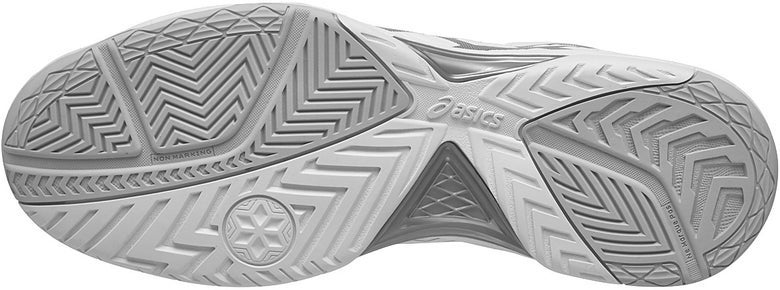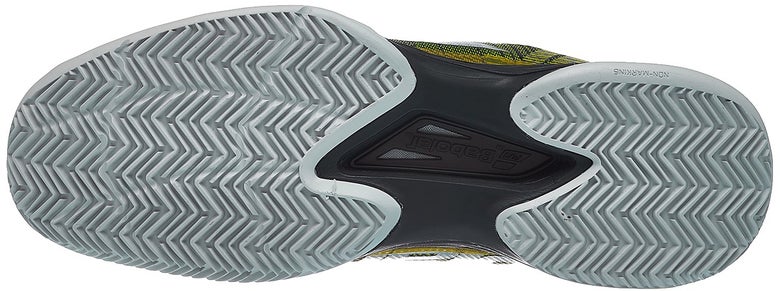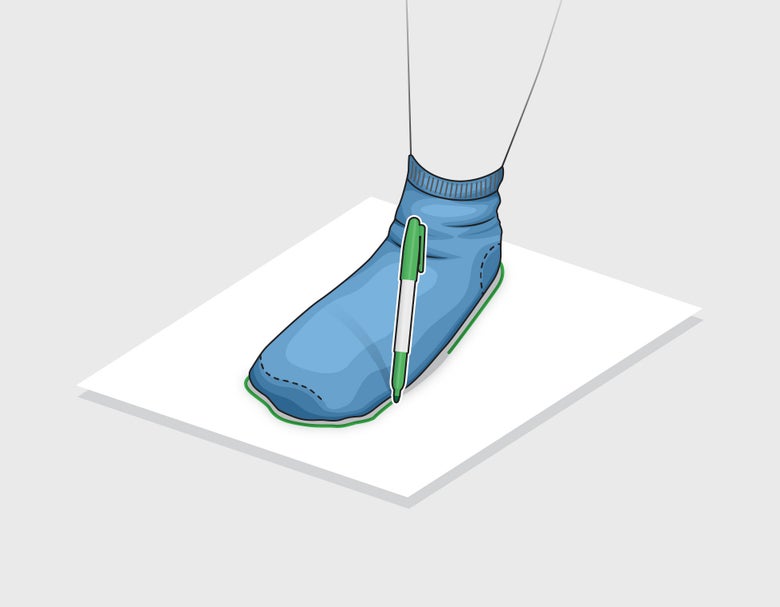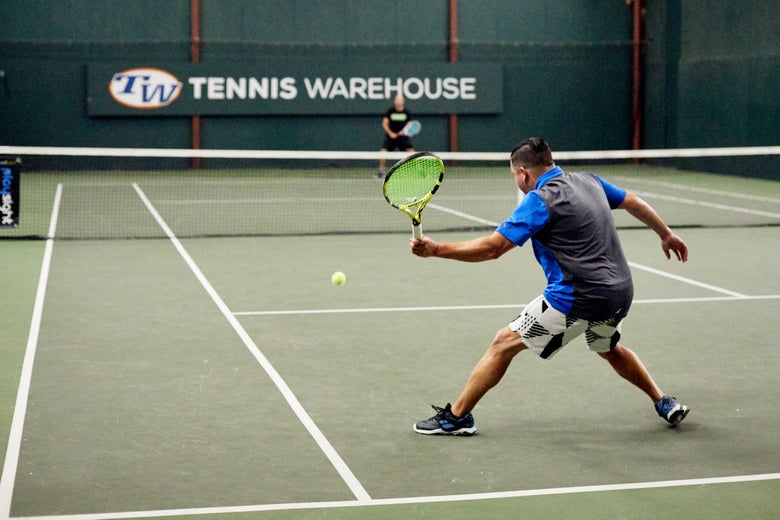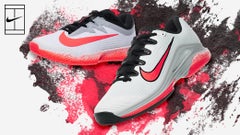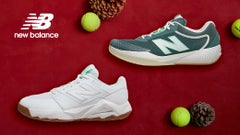How to Choose the Right Tennis Shoe
There are many factors to consider when you're choosing tennis shoes. Court surfaces, playing styles and foot shape all make a difference. Here's our three-step guide on choosing the best tennis shoes for you.
1. Why tennis shoes?
Tennis shoes vs. Running shoes
If you're new to tennis, you might wonder why you need specific shoes. Your running shoes might look like a good choice, but tennis shoes and running shoes are built for different movements. In tennis, we move side to side almost constantly, but when you're running, it's mostly just going forward. Tennis shoes are built with that side-to-side movement in mind and are designed to be more laterally stable. Tennis shoes will also be more durable, especially if you're playing on hard courts.
2. Which type of court do you play on?
Hard courts, clay courts or grass courts
Ideally, you want to choose a tennis shoe that has an outsole designed specifically for the type of surface you’re playing on. Why? Clay, hard, and grass courts all play differently; therefore, your game and footwork will also change slightly. To maintain optimal footing on each court surface, it’s important to wear a tennis shoe that is designed to handle the build of the court.
Hard Court Outsoles
The most common surface is a hard court. This court is also the most demanding when it comes to outsole durability. Usually hard court outsoles feature a modified herringbone pattern to give you the perfect blend of grip and give on the court. You'll find all kinds of hard court shoes from lightweight, speed shoes to more durable, stable options. Some shoes come with a six-month outsole guarantee because aggressive movers can wear out shoes quickly on hard courts. Most of the shoes at Tennis Warehouse will work on hard courts.
Listen In: Our playtesters talk about clay court shoes
Clay Court Outsoles
The outsole of a clay court shoe will usually feature a full herringbone (zig zags) tread pattern. This pattern helps keep clay out of your outsole so you can better grip the court when sprinting, stopping or changing directions. If some clay does gather, a couple of taps on the shoe with your racquet between points should knock the clay loose. The herringbone design makes sliding from side to side more predictable so you can perfectly glide into a shot and recover. It also provides the traction needed for securely moving forward and backward. If you plan on playing on clay on a regular basis, another reason why you'll want a pair of clay specific shoes is because they usually have a tighter knit upper that not only aids in stability but helps keep the clay from entering your shoes. Choosing the right tennis shoes will improve your comfort, your confidence and your performance on court!
Grass Court Outsoles
Like clay, grass is much softer on your body and joints. While there are not a ton of grass court shoe options to choose from, this surface tends to play fast, which means you will definitely want to wear a tennis shoe with a proper grass court outsole. The outsole of a grass court tennis shoe features "nubs" or "pimples" that are reminiscent of a cleat-like-shoe. This outsole provides great grip for players on a surface that can often be slippery. Despite the bumpy outsole, it shouldn't do any damage to the court and will help players feel comfortable moving quickly on this fast surface. Unlike hard court shoes, these cannot be used on other surfaces. Grass court shoes are difficult to find in the United States, but you can sometimes find them at our European site, Tennis Warehouse Europe.
2. Finding the Right Fit
How to Measure Your Foot
Step 1: Find a hard, flat surface and place a piece of paper on the floor.
Step 2: Wear socks that are similar to what you plan to wear when playing tennis. Stand with one foot on the paper.
Step 3: Keeping your body weight over your foot, trace a thin line around the outside of your entire foot. When drawing the line, hold the pen perpendicular to the ground.


Step 4: Measure vertically down the length of your foot tracing. This is your foot length.
Step 5: Measure horizontally across the widest part of your foot tracing. This is your foot width.
Find your shoe size & width
Make sure you are looking in the proper column, either men's or women's, when determining your size. The standard width for women is B. The standard width for men is D. *Note: This chart is here to give you a general idea on sizing and widths. Tennis Warehouse is not responsible for mismeasurements or ordering the wrong size. We recommend that you order the size that you normally wear in other shoes.
Men's Shoe Sizing Chart
| Length of foot | US Size | Width | |||
| Inches | Centimeters | C | D (standard) | E | |
| 9 1/3 | 23.7 | 6 | 3.3" | 3.5" | 3.7" |
| 9 1/2 | 24.1 | 6.5 | 3.3" | 3.6" | 3.8" |
| 9 2/3 | 24.6 | 7 | 3.4" | 3.6" | 3.8" |
| 9 4/5 | 25 | 7.5 | 3.4" | 3.7" | 3.9" |
| 10 | 25.4 | 8 | 3.5" | 3.8" | 3.9" |
| 10 1/6 | 25.8 | 8.5 | 3.6" | 3.8" | 4.0" |
| 10 1/3 | 26.2 | 9 | 3.6" | 3.9" | 4.1" |
| 10 1/2 | 26.7 | 9.5 | 3.7" | 3.9" | 4.1" |
| 10 2/3 | 27.1 | 10 | 3.8" | 4.0" | 4.2" |
| 10 5/6 | 27.5 | 10.5 | 3.8" | 4.1" | 4.3" |
| 11 | 27.9 | 11 | 3.9" | 4.1" | 4.3" |
| 11 1/6 | 28.4 | 11.5 | 3.9" | 4.2" | 4.4" |
| 11 1/3 | 28.8 | 12 | 4.0" | 4.3" | 4.4" |
| 11 1/2 | 29.2 | 12.5 | 4.1" | 4.3" | 4.5" |
| 11 2/3 | 29.6 | 13 | 4.1" | 4.4" | 4.6" |
Women's Shoe Sizing Chart
| Length of foot | US Size | Width | |||
| Inches | Centimeters | A | B (standard) | C | |
| 8 1/2 | 21.6 | 5 | 2.6" | 2.8" | 3.0" |
| 8 2/3 | 22.0 | 5.5 | 2.7" | 2.9" | 3.1" |
| 8 5/6 | 22.4 | 6 | 2.8" | 2.9" | 3.1" |
| 9 | 22.9 | 6.5 | 2.8" | 3.0" | 3.2" |
| 9 1/16 | 23.3 | 7 | 2.9" | 3.1" | 3.3" |
| 9 1/3 | 23.7 | 7.5 | 2.9" | 3.1" | 3.3" |
| 9 1/2 | 24.1 | 8 | 3.0" | 3.2" | 3.4" |
| 9 2/3 | 24.6 | 8.5 | 3.1" | 3.3" | 3.4" |
| 9 5/16 | 25 | 9 | 3.1" | 3.3" | 3.5" |
| 10 | 25.4 | 9.5 | 3.2" | 3.4" | 3.6" |
| 10 1/6 | 25.8 | 10 | 3.3" | 3.4" | 3.6" |
| 10 1/3 | 26.2 | 10.5 | 3.3" | 3.5" | 3.7" |
Now that you understand and know your width and length, look out for the fit details in our product descriptions to determine if the tennis shoes you are interested in are a good fit for your feet. We try on all the shoes we sell to provide you guidance on how they fit for length, width and arch support.
We also review many different shoe models to give you an idea of how they perform after hours on the court.
CHECK OUT OUR SHOE REVIEWS
3. Your game style
What kind of player are you?
Are you a light-footed, sprinting all over the court kind of player? Are you a hard hitting baseliner who is more concerned about ankle support? Or maybe you're looking for something in between.
You'll want to look for these buzz words when you're shopping for tennis shoes and reading our reviews.
Support and stability: When it comes to support, we are talking about how well shoes are holding your feet in place, not letting them slide around inside the shoes. For stability, we're talking about how rigid the shoes are and not allowing you to turn an ankle or fall over. With all the lateral movements in tennis, support and stability are primary concerns for many players. Supportive and stable shoes come in a variety of weights.
Lightweight: You'll hear us talk about whether shoes feel light. Many factors can make shoes feel light and fast on the court. We've learned from testing many tennis shoes over the years that the weight on the scale doesn't tell the entire story of how light or heavy shoes feel on the court. A light, fast feel could be due to fit, design or even traction levels. One caveat about light shoes is they are often not as durable. An easy way to make tennis shoes lighter is to use less rubber on the outsole. This won't make as big a difference if you're playing on clay courts, but frequent hard court players may notice that light shoes tend to wear out faster. That doesn't mean hard court players have to skip lightweight performance. Some players choose to rotate shoes, keeping lighter shoes for matches and more durable ones for practice days.
Durability: For those who play a lot on hard courts, how long the shoes last can be a big factor. Durability comes from the rubber compound used for an outsole as well as just how much of that rubber is used. Because of that, some (but not all) durable shoes may be on the heavier side. Some hard court shoes even come with a six-month outsole guarantee. That means if you wear through the outsole rubber to the midsole in less than six months, you can return them for another pair.

